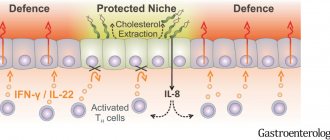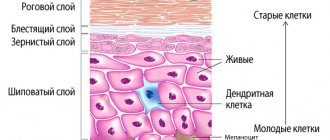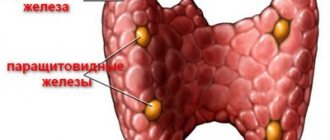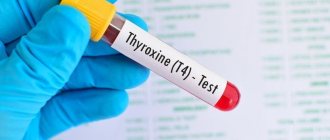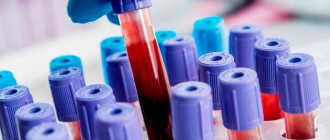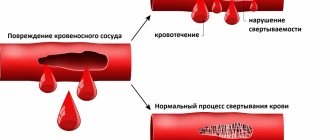Synonyms: immunoglobulins class M, IgM, class M antibodies.
Immunoglobulins (IG) are biologically active protein compounds in the blood (antibodies). They are produced by plasma cells and take an active part in the formation of the immune response to the invasion of foreign agents: bacteria, viruses, etc.
Class M IGs (IgM) are the very first to react to pathogenic microorganisms, which is why they are also called “alarm antibodies,” and trigger the process of further protecting the body from infection.
An IgM test is a diagnostic examination that allows you to determine the presence of acute or recurrent chronic pathologies, determine the form, stage and severity of their course, and also select the most effective treatment tactics.
general characteristics
Serum IgM makes up 5-10% of the total amount of immunoglobulins and is synthesized by mature B lymphocytes. IgM is the evolutionarily most ancient class of antibodies, primarily providing the primary immune response. Half-life 4-5 days. Activate complement via the classical pathway. They are the most large-molecular in structure. They do not pass through the placenta, so the detection of Ig M antibodies in a newborn confirms that the child himself is infected. IgM antibodies bind most effectively to complement, cause agglutination of bacteria, neutralize viruses, and play an important role in activating phagocytosis and eliminating pathogens from the bloodstream. The class of IgM immunoglobulins also includes isohemagglutinins, rheumatoid factor (in the early stages of the disease), and cold agglutinins. Some IgM is produced locally and is classified as secretory. Determining the content of serum immunoglobulin M has clinical and diagnostic significance for: recurrent, chronic or severe infections, rheumatoid arthritis and autoimmune diseases, tumor diseases, chronic hepatitis, liver cirrhosis, for monitoring the treatment of Waldenström's macroglobulinemia.
General information
Immunoglobulin M is produced only in the initial stage of the disease - at this moment the concentration of IgM in the blood serum rapidly increases. After 5 days (the half-life of M antibodies), class G immunoglobulins are synthesized. This is a kind of “heavy artillery” of the body, designed to finally eliminate the pathological focus.
However, IgM is an indispensable participant in the process of protecting the body in case of acute infection. They are the ones that are released into the bloodstream faster than all other antibodies and reach pathogenic cells, thereby providing humoral (primary) immunity.
Functions of immunoglobulin M
- Bonding and sedimentation of pathogenic microorganisms;
- Activation of the process of phagocytosis (absorption/eating of foreign agents by immune cells).
Patient preparation rules
venous blood
Standard preparation conditions (unless otherwise determined by the doctor):
8 hours before, withstand fasting, exclude fatty foods.
You can drink water. capillary blood Standard preparation conditions (unless otherwise determined by the doctor):
8 hours before, withstand fasting, exclude fatty foods. You can drink water.
You can add this study to your cart on this page
Normal for IgM. Factors of influence
The following reference values have been established for immunoglobulin M:
| Age | Floor | IgM indicators , g/l |
| 0 – 3 months | Male/female | 0,06 – 0,21 |
| 3 – 12 months | Male | 0,17 – 1,43 |
| Female | 0,17 – 1,5 | |
| 1 – 12 years | Male | 0,41 – 1,83 |
| Female | 0,47 – 2,4 | |
| Over 12 years old | Male | 0,22 – 2,4 |
| Female | 0,33 – 2,93 |
Note: the data provided cannot be used for self-diagnosis and self-treatment. Only a qualified specialist should interpret the results and prescribe treatment.
The following factors may affect the test result:
- violation of the rules for preparing for analysis by the patient;
- taking immunomodulators during the 6 months preceding the procedure;
- drug treatment with hormones and some other medications;
- radiotherapy (irradiation) or chemotherapy;
- diseases of the urinary system (chronic renal failure, damage to the glomeruli of the kidneys);
- massive burns of the body surface;
- multiple injuries;
- recent operations;
- chronic intestinal pathologies (Crohn's disease, ulcerative colitis).
Interpretation:
- Hyper-IgM syndrome, IgM-type multiple myeloma, asymptomatic monoclonal IgM gammopathy, Waldenström's macroglobulinemia, viral hepatitis, infectious mononucleosis, acute and chronic purulent infections, intrauterine infections in newborns (umbilical cord blood), bacterial and parasitic infections (early signs), enteropathy , hepatitis, biliary cirrhosis, rheumatoid arthritis.
It is advisable to interpret the level of immunoglobulin M in combination with immunoglobulins of other classes (A, G).
- It can be observed both in combination with a decrease in other classes of immunoglobulins and indicators of the immune system (Bruton's disease, common variable immunodeficiency, combined immunodeficiencies), and an isolated defect (selective deficiency of immunoglobulin M is determined at a level below 0.2 g / l), lymphoma, monoclonal (non-IgM) gammopathy.
Sample result (PDF)
Total immunoglobulin M (IgM)
Short description:
Antibodies of the IgM class, which are normally the first to be secreted during the humoral response of the immune system to the primary contact of the body with the antigen and are indicators of an acute infectious process. IgM predominantly circulates in the bloodstream and makes up 5-10% of all blood immunoglobulins. The half-life of IgM in the body is 5 days. Synonyms (rus): Immunoglobulins (antibodies) class M. Synonyms (eng): Immunoglobulin M; IgM, total, Serum.
Research method: Enzyme immunoassay.
Units of measurement: G/L (grams per liter).
Type of biomaterial: Venous blood.
Tube type: vacutainer with blood clotting activator (cap color: red with yellow ring)
Preparing for the study:
• Do not eat for 12 hours before the test. • Avoid physical and emotional stress 30 minutes before the test. • Do not smoke for 30 minutes before donating blood.
Completion time: 3 working days, Wednesday, Friday
Price: 312 rub.
Reference values
Age Reference values
Less than 1 year Less than 1.45 g/l 1 - 4 years 0.19 - 1.46 g/l 4 - 7 years 0.24 - 2.10 g/l 7 - 10 years 0.31 - 2.08 g /l 10 - 12 years 0.31 - 1.79 g/l 12 - 14 years 0.35 - 2.39 g/l 14 - 16 years 0.15 - 1.88 g/l 16 - 20 years 0, 23 - 2.59 g/l More than 20 years 0.4 - 2.3 g/l
Reasons for increasing the level of IgM immunoglobulins in serum: • acute bacterial, viral, fungal and parasitic infections; • convalescence phase after primary infection; • liver diseases (primary biliary cirrhosis, acute viral hepatitis); • autoimmune diseases (rheumatoid arthritis, systemic lupus erythematosus); • cystic fibrosis; • Waldenström's macroglobulinemia; • multiple myeloma (IgM type); • monoclonal cryoglobulinemia;
Reasons for a decrease in the level of immunoglobulins IgM in serum: • hypogammaglobulinemia, in particular physiological hypogammaglobulinemia in children aged 3-5 months; • severe combined immune deficiency; • agammaglobulinemia (Bruton's disease); • congenital IgM deficiency; • leukemia and lymphoma; • multiple myeloma (IgA- or IgG-type); • AIDS; • removal of the spleen (it contains a significant number of B cells - IgM producers); • amyloidosis; • Wiskott-Aldrich syndrome; • inflammatory diseases of the colon; • nephrotic syndrome.
Increases the level of IgM in the blood: • intense physical exercise; • severe emotional stress; • immunization in the previous 6 months; • taking certain medications (carbamazepine, chlorpromazine, dextran, estrogens, gold preparations, methylprednisolone, oral contraceptives, penicillamine, phenytoin, valproic acid.
Reduce the level of IgM in the blood: • renal failure, nephrotic syndrome (due to protein loss); • burns; • intestinal pathology accompanied by protein loss (Crohn's disease, ulcerative colitis); • immunosuppressants, cytostatics; • irradiation.
Code A09.05.054.003
Immunoglobulin E (IgE)
Immunoglobulin E (IgE) is one of 5 classes of immunoglobulins. IgE is present in plasma in much lower concentrations than immunoglobulin G (IgG). Total IgE is considered a marker of allergic diseases and parasitic infestations.
The function of IgE also differs from other immunoglobulins in that it induces the activation of mast cells and basophils through a receptor on the cell membrane of mast cells and basophils. Thanks to this interaction, almost all IgE produced by B cells binds to mast cells or basophils, which explains the low concentration of immunoglobulin in the blood under normal conditions. The attachment of IgE to the receptor leads to cell activation, the immediate release of biologically active cell components - histamine and tryptase, which entails manifestations of an acute allergic reaction.
In what cases is research usually prescribed?
Most often, a blood test for IgE is used in the diagnosis of atopic allergic diseases, some infections, and inflammatory processes. This test is necessarily prescribed if allergic bronchopulmonary aspergillosis and cystic fibrosis are suspected. The analysis is used in routine practice when allergic diseases and helminthic infestations are suspected. In case of hay fever (seasonal allergies), total immunoglobulin E and eosinophilic cationic protein - ECP are usually determined together.
What do the test results mean?
Elevated IgE concentrations usually indicate allergic diseases. Very high concentrations of total IgE are observed in patients with cystic fibrosis and aspergillosis.
An elevated concentration of total immunoglobulin E is not a diagnostic criterion for allergic diseases and should be interpreted by the attending physician taking into account patient data, including age, gender, travel history, exposure to an allergen and family history.
A normal concentration of total IgE does not exclude the presence of an allergy. In uncertain cases, testing for specific IgE to a specific allergen or panel of allergens may be ordered.
Test deadlines.
Typically, the result of a blood test for IgE can be obtained within 1-2 days.
How to prepare for the analysis?
No special preparation required. Detailed information can be found in the corresponding section of the article. If you suspect an allergy, it is better to get tested at the height of allergic manifestations.
How to decipher a blood test for total immunoglobulin E
The following indicators are considered reference values for immunoglobulin E in children:
- 0-3 months: from 0 to 2 kU/l;
- 3-6 months: from 3 to 10 kU/l;
- 6-12 months: from 8 to 20 kU/l;
- 1-5 years: from 10 to 50 kU/l;
- 5-15 years: from 16 to 60 kU/l.
Normal levels of immunoglobulin E in adults can range from 20 to 100 kE/l.
Deviation from the above norms, revealed during a blood test for total immunoglobulin E in individuals of both childhood and adulthood, may indicate the presence of a particular disease in the body or the development of a pathological process in it. In this case, the patient is prescribed additional examinations, during which it is established what is causing the disorder.
Preparation for IgM analysis
Preparatory measures for collecting blood from a vein in an adult or from the umbilical cord in a newborn are standard:
- Blood collection is carried out in the morning and strictly on an empty stomach (a period of overnight fasting of at least 10-12 hours). You are allowed to drink only clean, still water;
- 3-4 hours before the procedure, smoking and/or using nicotine substitutes (patch, spray, chewing gum) is prohibited;
- on the eve of the analysis, you should not drink alcohol, drugs, or energy drinks;
- the day before the test, you need to protect yourself from intense physical activity and emotional experiences;
- it is also not advisable to visit baths and saunas the day before the analysis;
- Before venipuncture, the patient must inform the doctor about all current courses of therapy, taking vitamins, etc.
Other tests to assess immunity
- Total immunoglobulin IgE
- Immunoglobulin IgA
- Immunoglobulin IgG
- Interleukins 1, 6, 8, 10
- TNF (tumor necrosis factor)
IgM below normal
There are congenital (rarely), acquired, and also caused by other reasons IgM deficiency. Although it is impossible to determine the specific type of immunoglobulin M deficiency based on the analysis, medical practice has proven that:
- congenital deficiency is a consequence of: Bruton's disease (immunodeficiency due to gene mutation);
- selective (selective) IgM deficiency;
- monoclonal gammopathy not associated with the IgM type;
- treatment with cytostatics or radiotherapy;

